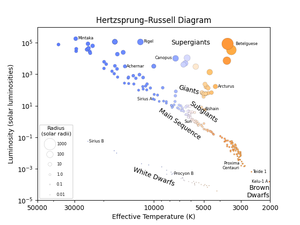Glossary term: Effective Temperature
Description: The effective temperature of a star is the temperature of a theoretical perfect emitter (a "blackbody") that has the same surface area and the same total light output as the star.
Stars have different layers with different temperatures, several of which contribute to what we eventually receive as starlight. Often astronomers find it useful to represent a star by a much simpler model, namely an idealized light-emitter called a "blackbody". A blackbody's total energy output is completely determined by specifying two parameters: its temperature and its surface area. The star's effective temperature is the temperature of a blackbody which has the same surface area and same total energy output as the star.
The effective temperature is one useful way to average the contributions to the star's light output from different parts of its outer layers and typically has a value very similar to the temperature of the star's photosphere – the surface layer where most of the star's light originates.
Related Terms:
See this term in other languages
Term and definition status: This term and its definition have been approved by a research astronomer and a teacher
The OAE Multilingual Glossary is a project of the IAU Office of Astronomy for Education (OAE) in collaboration with the IAU Office of Astronomy Outreach (OAO). The terms and definitions were chosen, written and reviewed by a collective effort from the OAE, the OAE Centers and Nodes, the OAE National Astronomy Education Coordinators (NAECs) and other volunteers. You can find a full list of credits here. All glossary terms and their definitions are released under a Creative Commons CC BY-4.0 license and should be credited to "IAU OAE".
If you notice a factual error in this glossary definition then please get in touch.
Related Diagrams
Hertzsprung-Russell diagram
Credit: IAU OAE/Niall Deacon
License: CC-BY-4.0 Creative Commons Attribution 4.0 International (CC BY 4.0) icons









